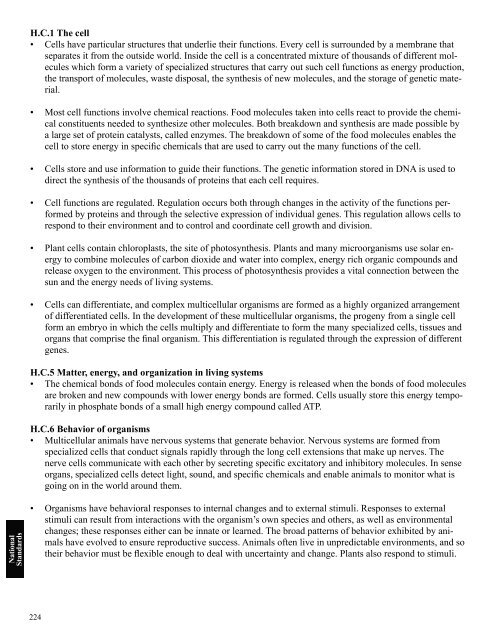ScienceMakers Toolkit Manual - The History Makers
ScienceMakers Toolkit Manual - The History Makers
ScienceMakers Toolkit Manual - The History Makers
Create successful ePaper yourself
Turn your PDF publications into a flip-book with our unique Google optimized e-Paper software.
National<br />
Standards<br />
H.C.1 <strong>The</strong> cell<br />
• Cells have particular structures that underlie their functions. Every cell is surrounded by a membrane that<br />
separates it from the outside world. Inside the cell is a concentrated mixture of thousands of different molecules<br />
which form a variety of specialized structures that carry out such cell functions as energy production,<br />
the transport of molecules, waste disposal, the synthesis of new molecules, and the storage of genetic material.<br />
• Most cell functions involve chemical reactions. Food molecules taken into cells react to provide the chemical<br />
constituents needed to synthesize other molecules. Both breakdown and synthesis are made possible by<br />
a large set of protein catalysts, called enzymes. <strong>The</strong> breakdown of some of the food molecules enables the<br />
cell to store energy in specifi c chemicals that are used to carry out the many functions of the cell.<br />
• Cells store and use information to guide their functions. <strong>The</strong> genetic information stored in DNA is used to<br />
direct the synthesis of the thousands of proteins that each cell requires.<br />
• Cell functions are regulated. Regulation occurs both through changes in the activity of the functions performed<br />
by proteins and through the selective expression of individual genes. This regulation allows cells to<br />
respond to their environment and to control and coordinate cell growth and division.<br />
• Plant cells contain chloroplasts, the site of photosynthesis. Plants and many microorganisms use solar energy<br />
to combine molecules of carbon dioxide and water into complex, energy rich organic compounds and<br />
release oxygen to the environment. This process of photosynthesis provides a vital connection between the<br />
sun and the energy needs of living systems.<br />
• Cells can differentiate, and complex multicellular organisms are formed as a highly organized arrangement<br />
of differentiated cells. In the development of these multicellular organisms, the progeny from a single cell<br />
form an embryo in which the cells multiply and differentiate to form the many specialized cells, tissues and<br />
organs that comprise the fi nal organism. This differentiation is regulated through the expression of different<br />
genes.<br />
H.C.5 Matter, energy, and organization in living systems<br />
• <strong>The</strong> chemical bonds of food molecules contain energy. Energy is released when the bonds of food molecules<br />
are broken and new compounds with lower energy bonds are formed. Cells usually store this energy temporarily<br />
in phosphate bonds of a small high energy compound called ATP.<br />
H.C.6 Behavior of organisms<br />
• Multicellular animals have nervous systems that generate behavior. Nervous systems are formed from<br />
specialized cells that conduct signals rapidly through the long cell extensions that make up nerves. <strong>The</strong><br />
nerve cells communicate with each other by secreting specifi c excitatory and inhibitory molecules. In sense<br />
organs, specialized cells detect light, sound, and specifi c chemicals and enable animals to monitor what is<br />
going on in the world around them.<br />
• Organisms have behavioral responses to internal changes and to external stimuli. Responses to external<br />
stimuli can result from interactions with the organism’s own species and others, as well as environmental<br />
changes; these responses either can be innate or learned. <strong>The</strong> broad patterns of behavior exhibited by animals<br />
have evolved to ensure reproductive success. Animals often live in unpredictable environments, and so<br />
their behavior must be fl exible enough to deal with uncertainty and change. Plants also respond to stimuli.<br />
224










